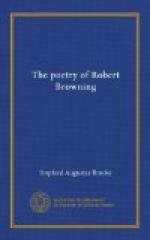4. The next thing I have to say about Sordello concerns what I call its illustrative episodes. Browning, wishing to illuminate his subject, sometimes darts off from it into an elaborate simile as Homer does. But in Homer the simile is carefully set, and explained to be a comparison. It is not mixed up with the text. It is short, rarely reaching more than ten lines. In Browning, it is glided into without any preparation, and at first seems part of the story. Nor are we always given any intimation of its end. And Browning is led away by his imaginative pleasure in its invention to work it up with adventitious ornament of colour and scenery; having, in his excitement of invention, lost all power of rejecting any additional touch which occurs to him, so that the illustration, swelling out into a preposterous length, might well be severed from the book and made into a separate poem. Moreover, these long illustrations are often but faintly connected with the subject they are used to illumine; and they delay the movement of the poem while they confuse the reader. The worst of these, worst as an illustration, but in itself an excellent fragment to isolate as a picture-poem, is the illustration of the flying slave who seeks his tribe beyond the Mountains of the Moon. It is only to throw light on a moment of Salinguerra’s discursive thought, and is far too big for that. It is more like an episode than an illustration. I quote it not only to show what I mean, but also for its power. It is in Bk. iv.
“As, shall I say, some
Ethiop, past pursuit
Of all enslavers, dips a shackled
foot
Burnt to the blood, into the
drowsy black
Enormous watercourse which
guides him back
To his own tribe again, where
he is king;
And laughs because he guesses,
numbering
The yellower poison-wattles
on the pouch
Of the first lizard wrested
from its couch
Under the slime (whose skin,
the while, he strips
To cure his nostril with,
and festered lips,
And eyeballs bloodshot through
the desert-blast)
That he has reached its boundary,
at last
May breathe;—thinks
o’er enchantments of the South
Sovereign to plague his enemies,
their mouth,
Eyes, nails, and hair; but,
these enchantments tried
In fancy, puts them soberly
aside
For truth, projects a cool
return with friends,
The likelihood of winning
mere amends
Ere long; thinks that, takes
comfort silently,
Then, from the river’s
brink, his wrongs and he,
Hugging revenge close to their
hearts, are soon
Off-striding for the Mountains
of the Moon.”




